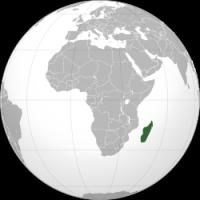|
|
|
The Republic of Madagascar (older name Malagasy Republic, -mgrepubliˈkʲan madaɡasˈkʲarə̥, ) is an island country located in the Indian Ocean off the southeastern coast of Africa. The nation comprises the island of Madagascar (at 587041 km2 (587041000000 m2), the fourth-largest island in the world), as well as numerous smaller peripheral islands, the largest of which include Nosy Be and Nosy Boraha (Île Sainte-Marie). The prehistoric breakup of the Gondwana supercontinent separated the Madagascar-Antarctica-India landmass from the Africa-South America landmass around 135 million years ago. Madagascar later split from India around 88 million years ago, allowing plants and animals on the island to evolve in complete isolation. Consequently, Madagascar is a biodiversity hotspot in which over 80% of its plant and animal species are found nowhere else on Earth. These are dispersed across a variety of ecoregions, broadly divided into eastern and south-central rain forest, western dry forests, southern desert and spiny forest. The island's diverse ecosystems and unique wildlife are severely threatened by human settlement and traditional slash-and-burn practices (tavy) which have denuded Madagascar of as much as 90% of its original forest cover. Under the administration of former President Marc Ravalomanana, the government of Madagascar partnered with the international community to implement large-scale conservation measures tied to ecotourism as part of the national development strategy. However, under Rajoelina's caretaker government there has been a dramatic increase in illegal logging of precious woods and the poaching and sale of threatened species such as lemurs in Madagascar's many national parks, several of which are classified as UNESCO World Heritage Sites. Most researchers believe Madagascar was first inhabited sometime between 300 BCE and 500 CE by Austronesian peoples arriving on outrigger canoes from Borneo in the Indonesian archipelago who were later joined around 1000 CE by Bantu migrants crossing the Mozambique Channel and establishing first on the North and West coasts. Arabs, East African, later Malay and Javanese, Indians, Chinese and European (primarily French) migrants settled on Madagascar over time, each one making lasting contributions to Malagasy cultural life. The Malagasy ethnic group is often sub-divided into sixteen or more sub-groups of which the largest are the Merina of the central highlands around Antananarivo, and the Betsimisaraka people of the eastern coast around Toamasina. The Austronesian origins of the earliest population are evident everywhere not only in the language and the physical appearance of many Malagasy people, but also in cultural practices related to the veneration of ancestors, the prevalence of : the valiha (a bamboo tube zither of East Asian origin) and the sodina flute in Malagasy musical traditions, the architectural methods and norms who share the same norms than in South East Asia (like the square foundations of habitations), and a cuisine based on rice that establishes the Malagasy people as the largest rice consumers per capita in the world. Bantu influences are evident - especially in the West coast and in the South - in the spiritual and monetary value placed on zebu. The first transcription of Malagasy using Arabic script (sorabe) and certain elements of Malagasy cosmology were introduced ca 1500 by Arabs, and islamised Indians and Indonesian people who were established on the Southeast coast (in the current Vohipeno and Manakara region). Malagasy, the Austronesian language spoken in various forms by the vast majority of the population, is the national language and one of two current official languages alongside French and English. The majority of the population adheres to traditional beliefs or Christianity, but followers of other faiths such as Islam and Hinduism are found in smaller numbers throughout the country. Until the late 18th century, the island of Madagascar was populated by a fragmented assortment of shifting socio-political alliances of varying sizes. Beginning in the early 19th century, however, the majority of the island was united and ruled as the Kingdom of Madagascar by a series of nobles (andriana) of the Merina ethnic group. The monarchy collapsed when the island was conquered and absorbed into the French colonial empire in 1896, from which the island gained independence in 1960. The autonomous state of Madagascar has since undergone four major constitutional periods, including a post-colonial First Republic under President Philibert Tsiranana (1960 - 1972), a Soviet-style socialist Second Republic under Admiral Didier Ratsiraka (1975 - 1991), and a democratic Third Republic under successive presidents Albert Zafy, Didier Ratsiraka and Marc Ravalomanana (1992 - 2009). Since 1992 the nation has officially been governed as a constitutional democracy from its capital at Antananarivo by an elected president who serves a renewable five-year term and is supported by the prime minister he or she nominates. However, following a popular uprising in 2009 instigated by then-mayor of Antananarivo and TGV political party president Andry Rajoelina, Ravalomanana was pressured to resign. Presidential power was then unconstitutionally transferred to Rajoelina with the support of a portion of the military. A 2010 constitutional referendum ushered in the Fourth Republic in which the nation continues to be managed by Rajoelina's unelected caretaker government known as the High Transitional Authority (HAT). Rajoelina (b. 1974), currently the youngest head of state in Africa, has failed to secure recognition from the international community, which largely views the current administration as illegitimate and has widely characterized Rajoelina's seizure of power as a coup d'état. In 2010, the population of Madagascar was estimated at around 20 million, 85% of whom live on less than two dollars per day. Ecotourism, agriculture, expansion of international trade and greater investments in education, health and private enterprise are key elements of Madagascar's development strategy. Under Ravalomanana, these investments produced substantive economic growth but the benefits were not evenly spread throughout the population, producing tensions over the increasing cost of living and declining living standards among the poor and some segments of the middle class. Current and future generations in Madagascar are faced with the challenge of striking a balance between economic growth, equitable development and natural conservation. |




 RSS
RSS